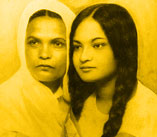

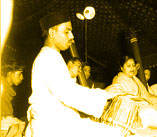
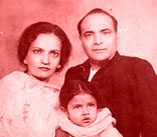


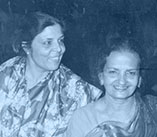
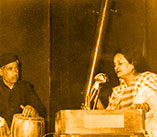
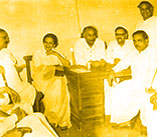
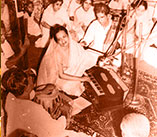
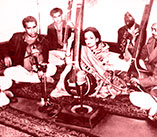
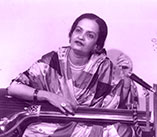
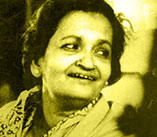
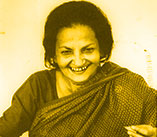



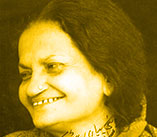
For most part, Akhtari grew up in Faizabad, Uttar Pradesh and Gaya, Bihar. A lively child, she used to narrate how she cut off one of her teacher’s plait because she found it “so beautiful”. Right from her early childhood, Mushtari Begum or Amma was a powerful influence in Akhtari’s life. She ensured that Akhtari received her formal training in singing from renowned Ustads and thus set the foundation for Begum Akhtar’s illustrious career.
Once Akhtaribai Faizabadi had become a voice to reckon with, it became a matter of privilege to be invited to her mehfils in Lucknow and Mushtari Begum managed the guest list with a hawk’s eye. Shanti Hiranand points out, “Mushtari Begum had always ensured that there was nothing but the highest class of entertainment for the highest level of clients at their private baithaks. Ammi, who was extremely close to her, never took exception to her behaviour. She loved and respected her Amma very much.”
When Akhtaribai Faizabadi decided to marry and transform into Begum Akhtar, the mehfils in Cheena Bazaar came to a sudden halt. Mushtari Begum was livid; she protested the marriage as her daughter was at the peak of her career. Over time, however, the strong bond between mother and daughter prevailed. “I am told there was so much love between the mother and daughter that right until the end, Mushtari Begum made it a point to send a messenger from Cheena Bazaar to Ammi’s house in Nayagaon daily, to check if she had eaten something and only when he returned with a reply would she eat her own meal”, Shanti Hiranand says.
Akhtaribai Faizabadi’s career in theatre & films started when she moved to Calcutta in 1927. She started performing on the stage and some old timers remember her playing “a vamp, dressed in a black velvet Western dress & smoking a cigarette with a long black holder” as S. Kalidas recounts in his book. Jaddan Bai was a source of inspiration for Akhtari, as she moved to Bombay to act in films such as Ek Din Ka Badshah and Nal Damayanti in 1933. Next year, she was seen in Ameena and Jawani Ka Nasha; and the year after in Naseeb Ka Chakkar. Her career in films continued till early 1940s but ended abruptly after that. Saleem Kidwai offers some insight when he says, “Begum Akhtar had everything she needed to be a star. She was dazzlingly beautiful, she had a screen presence and she sang like an angel. But her reluatnace to stay in films might have been rooted in her reluctance to dance. So much for a tawaif to be automatically a ‘nautch girl’! In Mehboob Khan’s Roti she was teamed with Sitara Devi. Yet she got to hum only one song. Sitara got to sing the rest because she could dance with wild abandon as a ‘sexually liberated’ lass. Akhtari’s performance was otherwise professionally competent.” Her last brush with cinema was in 1958 when Satyajit Ray convinced her to play a courtesan in a charming cameo for his classic film Jalsaghar.
Akhtaribai Faizabadi, along with many of her contemporaries such as Rasoolan Bai, Siddheshwari Devi, Kesarbai Kerkar, Badi Moti Bai, Anjanibai Mapekar, Gangubai Hangal, Hirabai Barodekar and Mogubai Kurdikar, was part of this tradition at a time when the society was going through a major shift. The contribution of Begum Akhtar to the light classical genre of music has been well accepted & acknowledged. To understand this contribution, it is important to view Begum Akhtar’s and of her contemporaries’ lives through the context their lives were embedded in.
Saleem Kidwai points out that tawaifs were part of the Nawabi elite society in Lucknow. He quotes Abdul Halim Sharar, “Until a person had association with courtesans, he was not (considered to be) a polished man.” Even though tawaifs suffered dire consequences with the advent of the British rule, they continued to play an important part as they were integrated into lives of elite. “Sons from rich families were sent to them to learn manners, the art of conversation and appreciation of Urdu literature”, says Saleem Kidwai while pointing out the paradoxical nature of power which these women exercised. He says, “Though dependent on men for income, they ruled their own world. Daughters inherited not only the profession of distaff side of the families but also the property. Sons were excluded & men at best played a subsidiary part in their personal lives. In fact, all the men associated with kotha were financially dependent on women. No man had the power over their personal lives, unless they chose to get married.” The demise of tawaifs corresponded with the demise of court patronage and, eventually, this tradition was completely washed over in post-independence India.
Akhtari rose to fame in an era during which the society was going through a rapid political as well as cultural transformation. It was being declared that All India Radio will not host artists whose private lives were public scandals. Akhtaribai Faizabadi’s life cannot be delinked from the patriarchy it was steeped in. Thus, her reasons to decide to get married vary from speculations about escaping a treacherous marriage with the Nawab of Rampur to the fact that she desired a certain position in the society which was not possible in her life as a courtesan. Whatever the reasons, her proposal to Ishtiaq Ahmed Abaasi, a London educated Barrister, has been considered a remarkable feat in social mobility.
According to Begum Sayeeda Raza, producer at All India Radio, Lucknow, Akhtari planned the marriage with the charming Abbasi sahib who was a widower but a fashionable and well respected aristocrat. He attended many private mehfils where Akhtari sang. Unknowing of this, Sayeeda Raza became an aide in fixing the marriage as Akhtari determinately approached her and said “Please get me married to him!” Even though taken aback by the upfront approach of Akhtari, she broached the topic with Abbasi sahib. He did not give a clear response at the time but Akhtari found a strong ally in Sayeeda Raza who herself belonged to an aristocratic family of Lucknow. In 1945, Akhtari married Ishtiaq Abassi and became Begum Akhtar.
Begum Akhtar straddled two inherently conflicted worlds – that of a Begum and a tawaif. She took her role as a Begum seriously and while initially she was ostracised by the women in Abbasi sahib’s family, she eventually won them over through lavish attention and generosity. Whatever earning she made were spent on buying gifts for all members of the extended family. She had a sharp awareness throughout her life that she was “not one of them” and so, no stone was left unturned. Through her unflinching love and generosity, she came to be known as Acchhi Ammi in her extended family, something which Shanti Hiranand talks about. She also says that Ammi would raise a furore in the house when it came to cooking elaborate meals for the guests of Abbassi sahib. The household would go into a frantic tizzy as Begum Akhtar had set ideas about the ways meals should be prepared and served. Nothing less than a royal treatment would be bestowed upon the guests at their Havelock Road house in Lucknow!
Though Begum Akhtar intensely loved her role as Begum sahiba of Mateen Manzil, she would tire of it soon and crave for something more. Sayeeda Raza reveals that during the initial years of marriage, “she did miss singing but she missed whisky more!” Contradictive narratives exist around the absence of Begum Akhtar from the music scene after her marriage and her return to singing as a way to overcome depression of her mother’s death. However, historian Saleem Kidwai says that Begum Akhtar stopped performing only for a little while & found respectable avenue to perform through All India Radio. However, throughout her life, she never performed publically in Lucknow following her marriage to Abbasi sahib. In his doctoral work on Begum Akhtar, Robert Ollikkala opines that Begum Akhtar was trying to adapt to the changing conditions of the society. She was aware that being part of a respectable family meant that it would be frowned upon to perform as it was still considered to be the domain of baijis. He believes that Begum Akhtar helped negotiate the change, but suffered for it.
Begum Akhtar’s senior disciples Shanti Hiranand and Anjali Banerji indicate that she was completely open & generous with her knowledge and eagerly gave everything that she could. This was mentioned in contrast to the reputation that at least some gharanedar ustadsof the time had of making a living from teaching and, at times, giving limited information for maximum financial return. Begum Akhtar often told Shanti Hiranand: “Har kuza ni’mat!” (“Every vessel is a blessing!”)
“If a student has the talent to surpass his teacher then it is the teacher’s good fortune. There is no greater sin than hiding things from your students,” Hiranand remembers her as saying.
“My understanding is that in those days there was a total dedication and deep love for the guru”, Shanti Hiranand writes in her biography, while reminiscing the old days of receiving ta’lim from Begum Akhtar. Hiranand narrates two specific incidents – separated by many years, yet deceivingly similar – that reveal her undying & unfailing love and devotion for her Ammi.
Hiranand, during her training, was almost like family in Begum Akhtar’s home on Havelock Road, Lucknow. On some evenings, the entire family would rest on cots and folding beds in the courtyard looking at the stars above. Hiranand would press her guru’s feet before going to sleep and this could go on for hours, until she eventually fell asleep crouching at Begum Akhtar’s feet. “This way, I could keep pressing her feet even if she woke up in the middle of the night,” she says.
Years later, following a misunderstanding, Hiranand was completely ostracized by Begum Akhtar. However, Hiranand persisted in her efforts to win her guru over and prove her innocence. One night Hiranand reached Marina hotel to meet Begum Akhtar and found that she was running a high temperature. She stayed with Ammi the entire night, pressing her feet.
Begum Akhtar: “Bitiya, why didn’t you ask me why I was angry with you? You silently suffered my injustices? Why?”
Shanti Hiranand: “I knew you loved me, and that one day you would have it in your heart to forgive me for any sins of omission or commission.”
Munne Khan was probably the only constant in Begum Akhtar’s famously dynamic life. He was her accompanist on the tabla almost throughout her professional sojourn. They journeyed together through the various phases of her life as an artist – from successes & celebrity as Akhtaribai Faizabadi to the revere of Begum Akhtar.
Almost every stage, performance, recording & mehfil saw them create magic together. Like all celebrated musical partnerships, this one too was one of deep respect & understanding of each other’s strengths and weaknesses. Munne Khan perfectly understood Begum Akhtar’s style of singing and composition “It is said Munne Khan played a special version of deepchandi to keep pace with her, which had 16 matras, as compared to the standard 14 matras. He secretly blended in two extra Tirkits to allow her the space to further develop her composition,” remembers Shanti Hiranand.
Shanti Hiranand remembers how Begum Akhtar got along famously with her contemporaries. She shared close friendships with a few, and was eager to learn from them. As her comtemporary Mallika Pukhraj remembers, she was generous in sharing her musical knowledge with her contemporaries and never had any animosty borne out of competitiveness.
Pandit Kumar Gandharva is known to have made it a point to visit Begum Akhtar whenever he was in Lucknow. She is known to have fussed over him, even cooking food for him herself. He considered her to be akin to an elder sister. She in turn respected him greatly as an artist. Hiranand remembers accompanying Begum Akhtar to Kumarji’s home in Dewas where they enjoyed a similar hospitality and sang together.
Hiranand often quotes that Begum Akhtar was an artist that sang from her ‘heart’ and not from her ‘head’. And that she recognised other artists that did the same and respected that quality to a great extent – Ustad Bade Ghulam Ali being one of them. They shared a special relationship and when they visited each others’ homes, they would sit for hours over tea exchanging innumerable stories.
Begum Akhtar was also deeply attached to Anjanibai Malpekar even though, funnily enough, their conversations ensued in Marathi & Urdu simultaneously. Anjanibai is known to have taught Begum Akhtar the famous thumri “Main toh tore damanwa lagi maharaj…”
It is said that Begum Akhtar shared a close relationship with some of the poets whose couplets she sang. Others hoped to be sung by her to kickstart their careers & win fame and recognition through her rendition of their words. Shanti Hiranand candidly remembers some anecdotes of famous poets:
“Behzaad Lucknawi, whose famous ghazal “Deewana banana hai toh deewana bana de…” launched her on her road to stardom was almost her court poet. He wrote most of his couplets with Begum Akhtar in mind and she, on her part, would sing anything written by him.”
It was Abbasi sahib who introduced her to more refined Urdu poets. His knowledge of refined Urdu poetry was vast and that became one of his major contributions to her professional career. Saleem Kidwai notes, “In those days it was a matter of honour among new poets to get the stamp of Begum Akhtar’s approval. Poets like Shamim, Shakeel & others would vie with each other to get their verses sung by her.”
Once she jokingly threatened Jigar Moradabadi, “I think I should marry Jigar sahib. Imagine what children we would have, blessed with my voice & your talent with words!” He was amused but fittingly countered saying, “But what if they ended up looking like me?” This had the entire mehfil in fits, including Jigar sahib’s wife!
Shortly before Firaq died. Ammi had gone to see him at his hotel in Paharganj. He was breathing heavily but had a warm smile for her. He gave her one of his ghazals:“Sham-e-gham kuchh us nigah-e-naaz ki batein karo, bekhudi badhti chali hai raaz ki batein karo…”
Shanti Hiranand remembers how the famous ghazal, “Aye mohobbat tere anjaam pe rona aaya...” started as a little chit that Shakeel stuffed into Begum Akhtar’s hand as he bid them farewell at Bombay Central Station. Travelling back to Lucknow in spacious old style compartments, Begum Akhtar puffed away her cigarettes all night long. In the morning, she brought out her travel Harmonium and set the opening chords of the song that was to become her all-time hit.
Few weeks before she passed away, All India Radio had organized a mehfil which had a direct broadcast. Kaifi Azmi wrote a fresh verse which Begum Akhtar would render into a song. Shanti Hiranand believes it to be one of her most stunning live performances ever!
In an interview with Acharya Kailash Chandra Dev Brihaspati, she revealed “Gaane ki ruh taseer hai… Agar theek se gaun toh uska asar dil par hona chahiye!” (The soul of a song lies in its affect. If my singing is effective, it should reach the heart of my listeners!) This was her connection to the music she created, seemingly effortless yet delicately touching strings of the listeners’ hearts.
“Hamara toh aisa hi rishta hai Allah Miyan se, jab ji chahega tab dua karungi, jab nahin chahega toh nahi karungi. Gunehgaar toh hun hi!” (This is my personal equation with God. I will pray when I want, not when I don’t want. I will always be regarded as a sinner in any case!) Her words, as reported by Shanti Hiranand, beautifully depict her relationship with God. Hiranand highlights an incident where, during a concert, Begum Akhtar suddenly decided to go to Mecca for Haj pilgrimage. She was dissuaded by the authorities as she had been to Mecca just a year ago with her husband. Not caring about the opinions of others, she bought a ticket using her programme fee and flew off. In Medina, she did not have money but sat by the Prophet Mohammed’s tomb and started to recite a na’t. People soon recognized who she was & the local radio station approached her to be recorded. Using the payment from the recording, she completed the rest of her journey!
Not only Islam, her faith had limitless capacity. Once she mentioned to Shanti Hiranand, “Krishna is the God of love & anyone who doesn’t love Krishna cannot possibly sing”.
Begum Akhtar was famous for her candidness. Shanti Hiranand recounts an instance when she was crossing the Wagah border with Begum Akhtar to perform in Pakistan.
“They flipped through my papers a couple of times and looked me up & down. My crumpled Sari, my little Bindi & my shy smile did not impress them. The senior officer mustered the courage to say, “Shanti Hiranand Akhtar. What kind of a name is that?”
“She is my daughter!”, Ammi said confidently.
“Your daughter! Shanti!” He was almost shouting at us now.
“We are like this in India. I don’t know how it is in Pakistan”, said Begum Akhtar. This to me was essentially Ammi”, recounts Shanti Hiranand.
In an interview with Acharya Kailash Chandra Dev Brihaspati, she candidly spoke about her teaching techniques. “Jo sikhna hi na chahe, sirf ye chahe ki mujhe Radio mein audition karwa dein sahib, unhein keh deti hun ki jao Brihaspatiji ke paas!”
Once, after a visit to Afghanistan, she emerged out of the airport looking like royalty. However, Munne Khan came out holding a bunch of jhadus, looking ridiculous. That hardly mattered to Begum sahiba.She had bought jhadus to give to everyone. Not only did she give them out as gifts, she expected everyone to praise how good they were!
Begum Akhtar carried herself with such an unassuming air that her misgivings & shortcomings, her teasing & coquetry would all be forgiven and forgotten in an instant.
Partha Chatterji speaks of the generosity of Begum Akhtar’s spirit and how it impacted her music. He says, “Conventional bourgeois respectability has no place in the mind of an artist although he/she may pay lip service to it. Not that an artist is amoral, Begum Akhtar was not. But a deeper, more generous kind of morality in which giving is more important than taking, is what concerns the truly ‘sureela’ or tuneful being which Begum Akhtar was. If the balance sheet of her life is drawn up, it will be shown that she gave a lot more than she received and never took anything from anyone. She had the grace of giving & receiving. This benevolence extended to her music as well.”
As Chatterji points out, this generosity extended to every aspect of her life. It reflected in her showering people with expensive gifts, or on a whim giving a personal possession if someone appreciated it to the fact that she never held any musical knowledge back while teaching or to her listeners, for whom she lay all her emotions bare.
Agha Shahid Ali, a scholar known for his adaptation of the structure of ghazal to English poetry was one of Begum Akhtar’s many admirers. His conversations with Amitav Ghosh and Saleem Kidwai revealed that he was in love with her. In his apartment, Ghosh writes, “were shrines of people he loved including his parents, James Merrill and Begum Akhtar.” A deep reverence for her impacted his entire being. He priced not just her music but also the wordplay, wit & nakhra she brought to the ghazal. Shahid had stories of Begum in sharpness of her repartee. He had internalized these aspects, so far as to respond to a security guard at Barcelona Airport, on her asking if he was carrying anything which could hurt other passengers and he said “Only my heart.” Ghosh points out that not only nakhra, but the “idea that sorrow has no finer mask than a studied lightness of manner” bound the two in an extricable relationship.
Begum Akhtar’s grief-stricken image at her mother’s death followed Shahid till the end when, in his untimely farewell to the world ‘I Dream I Am At The Ghat Of The Only World’, he wrote:
A night of ghazals comes to an end. The singer
departs through her chosen mirror, her one diamond
cut on her countless necks. I, as ever, linger.
“Of all the personas she donned, the one Akhtar identified with most was that of the unrequited lover in pain.” S. Kalidas shares a beautiful couplet of Ghalib, ‘Ishq se tabiyat ne zeest ka maza paya, dard ki dawa payi, dard-e-ladawa paya’ (Love taught the mind joys of life, gave it medicine for pain, and gave it pain that has no remedy)
The melancholy in the voice of Begum Akhtar mirrored the heartbreak and pain she felt constantly. Sheila Dhar, in a conversation with Kalidas, poignantly says, “It was very important for her to be in love and be pained by it. If love didn’t happen she would invent it & if that love didn’t have pain, she would invent that too! She would take the smallest misunderstanding grievously to heart. The slightest injury to her ‘self’ would torment her like a dagger driven deep into her heart. And this imaginary dagger would remain buried in her till she had extracted every iota of painful pleasure from it!”
Her association with Ustad Amir Khan, a great exponent of khayal gayaki has been narrated by Sheila Dhar. On receiving the news of his demise in a gathering at a businessman’s house in Mumbai, someone innocuously mentioned what his wife must be going through. Begum Akhtar, present at the gathering, sharply said “Which one?” and burst out laughing. Soon, she left for her hotel and when no news of her arrived for two days, someone went to check on her. On opening the door he met a dishelved and a distraught Begum Akhtar, who had not showered, changed her clothes or eaten in two days. She told Shanti Hiranand that she will not live for too long, and passed away before the year ran out. Love as a condition of life pursued her till the end.
Begum Akhtar passed away doing what she held closest to her heart – performing on the stage. Shanti Hiranand talks about an incident which Shammo swore to be true.
As was the custom, three months after her death, her temporary grave was dug up so that a permanent structure could be placed. Shammo, present at the grave site, requested one of the workmen to uncover just one plank so she could see Ammi’s face one last time. Despite being against tenets of the religion, Shammo pleaded with tears in her eyes. Relenting to Shammo’s request, the workman uncovered one of the planks while carefully averting his gaze.
“According to Shammo, at first, her perfume filled the air; the same smell that I particularly associated with her, a mixture of tobacco and her favourite scents. Ammi had always been extremely fond of perfumes. Then Shammo said she gathered her nerves to look. She claims that when she actually looked down, Ammi lay pristine, intact, complete, just the way she had been the day she had been interred. Not a tissue in her frame had deteriorated with the passing of the months. Even her hair remained untouched by death, in fact a lusty lock of her hair had come out despite the restraining headgear!”
This is how Begum Akhtar is remembered even today – pure, complete and untainted. Neither the circumstances she faced in her life nor the inevitable death could ever fade her spirit.
The true essence of Begum Akhtar is revealed by how she is remembered. In describing her life and character, noted critic Raghava Menon writes, “Akhtar was constantly caught up in a male-dominated world. She could never escape, even when in the middle class, for there were inescapable social stigmas. But, it seems to me, she had an understanding of the predicament of the human being, and she used her life as a source of understanding of the masses who have looked for things, searched for things, gone on a journey to discover things and, in some cases, come back empty handed, finally realizing that the important thing is the journey. She seemed like that to me. She was a remarkable, highly evolved woman.”


